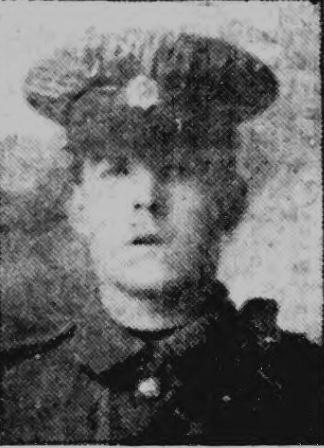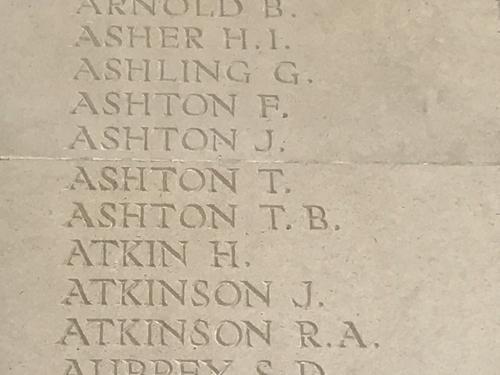Biography of Private John Thomas Ashton (43328)
8th Battalion Lincolnshire Regiment
Formerly T/2/11246 of the Army Service Corps (Driver).
Died 20th April 1917
Soldier
- Name: John Thomas Ashton
- Date of birth: 1894
- Place of Birth: Morton, Lincolnshire, England
- Date of Birth Registration: October – December 1894
- Place of Birth Registration: Bourne, Lincolnshire, England
Father
- Name: William Ashton
- DOB: 1866
- Place of Birth: Morton, Lincolnshire, England
- Occupation: Labourer (General)
Mother
- Name: Elizabeth Cox
- DOB: 1869
- Place Of Birth: Stainfield, Lincolnshire, England
- Marriage: 25th November 1890 Morton, Lincolnshire, England
Siblings: (Name), (DOB), (POB)
- Gertrude Cox, 1888, Stainfield (Half sister)
- FLora Millicent Ashton, 1891, Morton (Died 1893)
- William Edward Ashton, 1892, Morton
- John Thomas Ashton, 1894, Morton
- Albert Ashton, 1897, Morton
- Gordon Ashton, 1899, Morton (Died 1899)
- Doris Kathleen Ashton, 1904, Morton
- Edna Phyllis Ashton, 1908, Morton (Died 1909)
Census
- 1901: John is living with his parents in Morton, Lincolnshire.
- 1911: John is living with his parents in Hanthorpe Road, Morton, Lincolnshire. The census gives him an age of 16 and he is listed as a farm labourer.
Relatives in services
- John’s cousin Arthur Ashton also fought and was killed in WW1. Arthur can be found on our page dedicated to the Morton War Memorial.
Marriage
- No marriage for John has been found and because of his age we can assume that he never had the opportunity to marry.
Newspaper Mentions
- Grantham Journal Saturday 3rd October 1914
MORTON
KITCHENER’S ARMY. – Nine men have volunteered from these parishes, vix., Haccinby, Robert Wand, Robert Wilson Wye, Edmond Wye, William Wye, Jack Healey; Morton Fisher Handford, William Holmes, George Smith, John Ashton. We trust that others will be actuated by their splendid examples and follow suit. (Wye is Wyer)
- Lincolnshire Echo Friday 22nd June 1917
LOCAL CASUALTIES
MISSING
LINCOLNSHIRE REGIMENT
Ashton, 43328 Pte. T. (Bourne)
- Nottingham Evening Post Friday 22nd June 1917
LOCAL CASUALTIES
MISSING
LINCOLNS.
Ashton 43328 T. (Bourne)
- Sheffield Daily Telegraph Friday 22nd June 1917
MISSING
LINCOLNS.
Ashton (43328), T. (Bourne)
- Grantham Journal Saturday 9th march 1918
MORTON
SAD NEWS – Mr. and Mrs. William Ashton, of Hanthorpe Road have received the sad intelligence that their second son, Pte. Jno. Tom Ashton, who was reported missing some months ago, is now officially reported killed. Great sympathy is felt for the bereaved parents.
- Grantham Journal Saturday 30th March 1918
Private THOMAS ASHTON, of Morton
Pte. Thomas Ashton, of the Lincolns, who was reproted missing in April of last year after the offensive on the Arras front, is now deemed to have been killed in action. It is thought that while lying wounded he may have been fatally injured by shell fire. Deceased was the son of Mr. and Mrs. Ashton, of Morton, and great sympathy is felt for them in their sad loss.
Military Records
Attestation Papers
- None found
Soldier’s Died In The Great War
- These records show that Private Thomas Ashton, 43328, 8th Bn Lincolnshire Regiment was killed in action on 20th April 1917 in the Western European Theatre in France and Flanders.
Pension Records
- Available
Effects Left To
- Father William
Medals
- The British Meda
- The Victory Medal
- The 15 Star
Memorials
- UK:
- Morton, Roll of Honour in St John the Baptist Church
- Commonwealth War Graves Commission:
- In memory of Private Thomas Ashton, 43380, 8th Bn., Lincolnshire Regiment who died on 20 April 1917 Age 21
- Son of William and Lizzie Ashton, of Hanthorpe, Morton, Bourne, Lincs.
- Remembered with honour, Arras Memorial
- Bay 3 and 4.

© BNA

© Picture taken by South Lincolnshire War Memorials

© Picture taken by South Lincolnshire War Memorials
Military Service Timeline
- Although his full name is John Thomas Ashton, all war office records show a name of Thomas Ashton. There is no doubt that this is the same person as reference is made to his parent’s names on the CWGC records.
- The War office records allude to the fact that Thomas Ashton was formerly T/2/11246 of the Army Service Corps.
- Thomas entered into France, his first theatre of action, on the 9th of May 1915.
- Currently we are unable to track down the war office records for Thomas Ashton and so his movements within France between May 1915 and April 1917 are unknown.
- It is known that Thomas Ashton Died on the 20th April 1917, age 21. This date falls between the 1st battle of The Scarpe (A river just to the north of Arras) 9th -14th April and the Second Battle of The Scarpe 23rd & 24th April 1917. Both of these battles saw heavy action for the 8th Battalion of the Lincolnshire Regiment and it has to be assumed that Thomas died as a result of action in the first battle.
- Thomas joined the 8th Battalion Lincolnshire regiment although records indicate a previous territorial service with the Army service Corps.
- His service records appear to have been lost in a fire in the blitz and so we can only really see what his movements may have been by looking at the 8th Battalion Diaries.
- Again it is unclear if he was with the Battalion from the start although he was awarded the 1915 star for service abroad in 1915 and this is consistent with the date that the 8th Battalion was posted to France.
- The Battalion trained at Grimsby during August 1914, and then at Halton Park in November. The Battalion moved into billets at Leighton Buzzard for the winter of 1914
- In the spring of 1915 the Battalion moved to Halton Park Camp, Wendover and miniature rifle practice commenced. After completing the musketry course and a Review by Lord Kitchener, the Battalion moved to Witley Camp North, marching past His Majesty the King and Lord Kitchener, 12 August 1915.
- All the Battalion commanders had been in retirement at the outbreak of war. Of the 21st Division in which the 8th Lincolnshire were attached only 14 officers had any previous experience in the Regular army.
- The Battalion entrained for overseas service at Milford Station on 9 September 1915 leaving England the next day, sailing via Folkestone to Boulogne. For a week the Battalion stayed in the Watten area before receiving orders to move to the front.
- A long and really arduous march took place which led the Battalion to the front and their first engagement of the war, The Battle of Loos.
- During this battle an immediate gain was overturned and the highly inexperienced Battalion suffered tremendous losses.
- In their first battle the 8th Battalion lost 22 of their 24 officers. 471 other ranks were killed, wounded or missing that being nearly half of all men in the Battalion.
- The next major offensive for the Battalion was during the battle of the Somme in July 1916. The Battalion saw action in Albert, Bazentin Ridge, Fleurs-Courcelette, Morval, Gaudecourt, Transloy Ridge and eventually in November the Battle of The Ancre.
- During the spring of 1917 the German Army retreated to the heavily fortified defensive Hindenburg Line.
- When the retreat started the 21st Division were at Halloy spending a period out of the line in training exercises.
- On the first of April the Battalion attended a voluntary Church Parade at Neuville Au Cornet before the following day being route marched to Denier for an attack on a trench system. Over the next days the Battalion moved to Avesnes-le-Conte, Givenchy-le-Noble, Lattre St Quentin before arriving at Duisans to withdraw equipment ready for their move onto the assembly area at Arras.
- The Battalion entered the Battle of Arras at Battery Valley on the 9th April 1917 at 4pm digging in until 8pm.
- The Battalion moved east and halted around midnight. At daybreak considerable enemy activity was observed round Monchy-le-Preux, also enemy troops and transport moving north east from Roeux. Artillery was asked for in both cases but there was no response.
- At 9am the Battalion prepared to advance to its original objective as soon as the 111th brigade advanced on Monchy.
- At 10:30 am Major Greatwood was informed that the 8th Somerset Light Infantry were in Monchy and that he must support them. They advanced to teh valley but in this advance they suffered heavy casualties as they had no artillery support.
- At 4pm Major Greatwood issued orders to attack Monchy with the 8th Somerset on the right, Lincolns on the left. Again with no artillery support they had to dig in on high ground receiving orders to attack at dusk.
- When they had already opened out for the attack, orders arrived from Brigade cancelling the attack and consolidate the position and patrols were posted in front.
- By the end of the 10th April the Battalion had 9 officers wounded, 30 other ranks killed, 187 other ranks wounded and 8 missing.
- On the 12 the Battalion were withdrawn from the line back initially to Arras and then a day later back to billets in Duisans and the on to Beaufort on the 14th April.
- The Battalion did not return to Arras until called into reserve and bussed into the town on the 20th. Next going into the front line in the 23rd April.
- It is reasonable to assume that Thomas Ashton, official date of death 20th April, was one of the wounded or more likely missing on the 10th April. The fact that he has no know grave and is listed on the Arras Memorial would point to him being one of the missing.
Sources
- WW1 Soldier’s Records (www.ancestry.co.uk)
- British Newspaper Archive.
- Fold 3
- Find My Past
- Genealogist
- Forces War Records
- British Army Service Numbers
- War Gratuity Calculator
- Commonwealth War Graves Commission
- National Archives – Battalion War Diaries
- General Registry Office